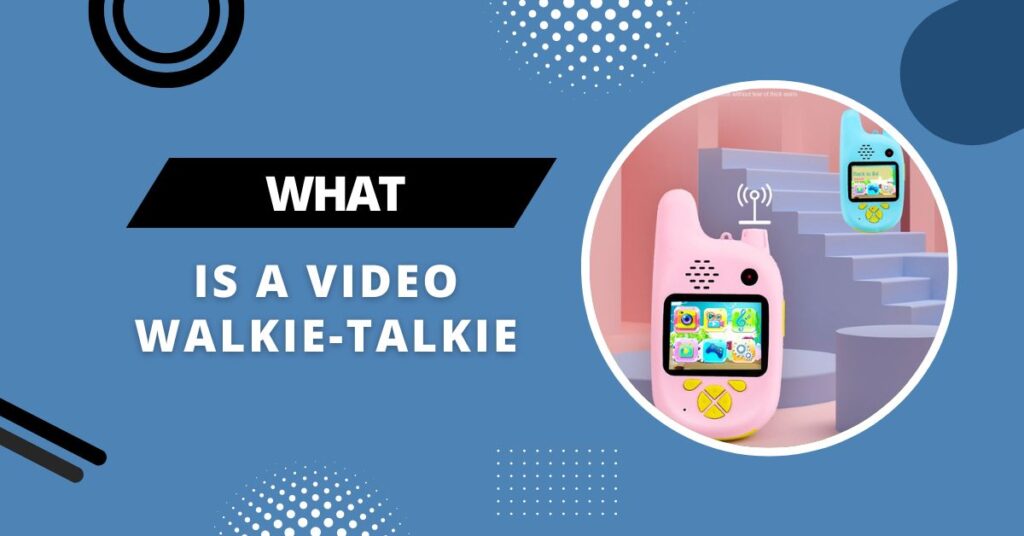Last updated on January 25th, 2023 at 01:35 pm
Learn about the latest communication technology – What is a video Walkie-talkie? It combines the convenience of a traditional walkie-talkie with the added feature of video communication for enhanced collaboration and remote work.
Introduction:
The video walkie-talkie, also known as a video intercom or video push-to-talk, is a type of communication device that incorporates the functionality of a traditional walkie-talkie with the addition of video capability.
As with video calls made on a smartphone or computer, this technology allows users to conduct two-way, real-time video and audio conversations.
It is becoming increasingly common for video walkie-talkies to be used in industries such as construction, security, and logistics, since they allow team members to communicate and collaborate more effectively, even when they are working remotely or from different locations.
What is a video Walkie-Talkie?

A video walkie-talkie, also known as a video intercom or video push-to-talk, is a type of communication device that combines the functionality of a traditional walkie-talkie with the added feature of video communication.
This technology allows users to conduct real-time, two-way video and audio conversations with one or more individuals, similar to a video call on a smartphone or computer.
Wi-Fi or Cellular Data
Video walkie-talkies typically use a wireless connection, such as Wi-Fi or cellular data, to connect users to each other. Many modern video walkie-talkies also include additional features, such as GPS tracking, text messaging, and group calling, to enhance collaboration and communication among team members.

Smarcent Walkie-Talkies with Camera for Kids
Kids Rechargeable with 8MP Dual Lenses Camera 2.0 inch IPS Screen and 32GB TF Card for Girls and Boys (2 Pack Blue)
Main Advantage
One of the main advantages of video walkie-talkies is their ability to provide real-time visual communication, which can be particularly useful in industries such as construction, security, and logistics.
Example
Remote
Video walkie-talkies can also be useful for remote teams and telecommuting employees, as they allow for face-to-face communication and collaboration, even when team members are working from different locations.
Final Words
Overall, video walkie-talkies offer a convenient and effective communication solution that can help improve collaboration, productivity, and safety in a variety of industries.
1. Smarcent Walkie-Talkies with Camera for Kids

“Smarcent Walkie Talkies with Camera is a fun and innovative communication device designed specifically for children. These walkie-talkies come with built-in cameras so children can take pictures and videos as they play.
With a range of up to three miles, these walkie-talkies allow kids to keep in contact with friends and family while they play and explore. They also have a compact and durable design that makes them ideal for outdoor adventures. The easy-to-use design and clear sound quality make these walkie-talkies a great choice for kids of all ages.“
Key Feature of Smarcent Walkie Talkies
Importance:

Video walkie-talkies are becoming increasingly important in today’s fast-paced and highly connected world. They offer a number of advantages over traditional walkie-talkies and other forms of communication, making them a valuable tool for a wide range of industries and applications.
1. Real-time visual communication:
One of the main advantages of video walkie-talkies is their ability to provide real-time visual communication, which can be particularly useful in industries such as construction, security, and logistics. This allows team members to easily share information and collaborate, even when they are working remotely or in different locations.
2. Improved collaboration and communication:
Video walkie-talkies can also improve collaboration and communication among team members, thanks to additional features such as GPS tracking, text messaging, and group calling.
3. Remote work and telecommuting:
Video walkie-talkies are also useful for remote teams and telecommuting employees, as they allow for face-to-face communication and collaboration, even when team members are working from different locations.
4. Safety and emergency response:
In emergency response scenarios, video walkie-talkies can be an invaluable tool for quickly and effectively communicating with team members and coordinating efforts to respond to an emergency situation.
5. Cost-effective:
Video walkie-talkies can be a cost-effective communication solution for small and large organizations, as they do not require expensive infrastructure or hardware and can be easily integrated with existing systems.
Final Words
Overall, video walkie-talkies are a valuable tool for improving collaboration, productivity, and safety in a variety of industries, making them an important technology in today’s connected world.
FAQs
1: How does a video walkie-talkie work?
A video walkie-talkie typically uses a wireless connection, such as Wi-Fi or cellular data, to connect users to each other. Users can initiate and receive video and audio calls, and also share live footage, text messages, and location information.
2: What are the advantages of using a video walkie-talkie?
Some advantages include real-time visual communication, improved collaboration and communication among team members, and the ability to communicate effectively in remote work and emergency response situations.
3: What are some industries that use video walkie-talkies?
Video walkie-talkies are commonly used in construction, security, logistics, and other industries where real-time communication and collaboration are important.
4: Are there any limitations to using a video walkie-talkie?
Some limitations may include limitations in the range, dependent on the wireless connection, and the number of devices that can be associated with a single phone number. Additionally, the cost of the device and the cost of the wireless connection can also be a limitation.
Conclusion
Video walkie-talkies are a valuable tool for improving collaboration, productivity, and safety in a variety of industries. They offer real-time visual communication, improved collaboration, and communication among team members, and the ability to communicate effectively in remote work and emergency response situations.
They have a wide range of use cases in various industries and can be cost-effective communication solutions. However, it’s important to consider the limitations and costs before making the investment.
